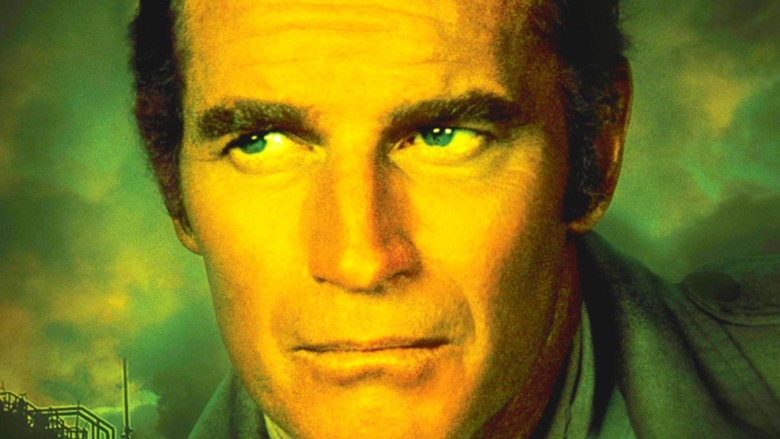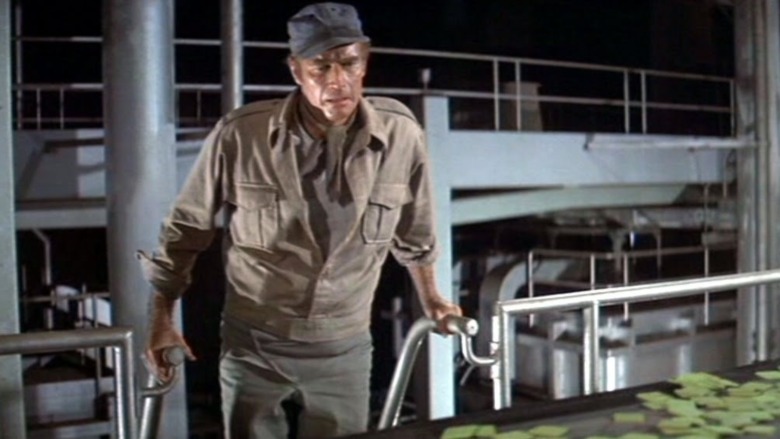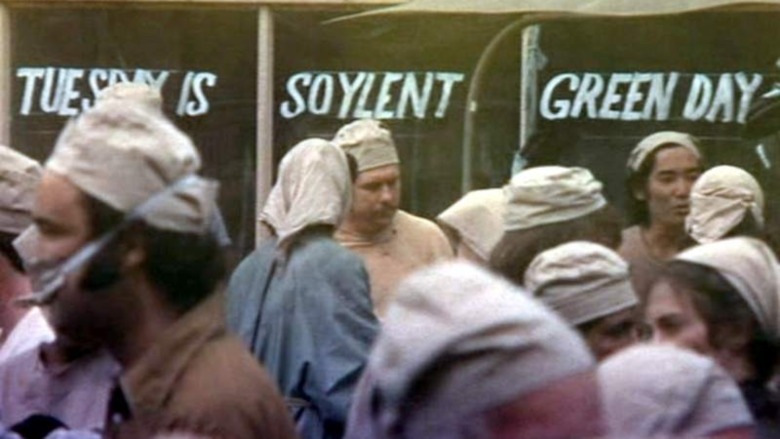The Ending Of Soylent Green Explained
Soylent Green is a dystopian science-fiction film set in the year 2022 where society has been ravaged by climate disasters, over-pollution, and overpopulation and only the wealthiest people in the world can afford natural food and a decent place to live. That means as of this writing, we only have one more year to turn things around before we find ourselves with the career option of "furniture."
Even if you've never seen the movie before, the phrase "Soylent Green is people" is well-known throughout the zeitgeist. However, the story is so much more than that single declaration. The film has been highly influential, inspiring future projects like Westworld and Sorry to Bother You. There's even a real-life meal replacement product called "Soylent" you can buy right now.
The story itself is fairly straightforward, where an NYPD detective Frank Thorn (Charlton Heston) investigates the murder of a prominent board member for Soylent Industries. As he investigates, he learns more and more about the dark, seedy secrets hidden within this world, and nearly 50 years after it first came out in 1972, the film still holds up immensely well. It doesn't rely on aliens or massive special effects to get its point across. Instead, it thrives with highly effective social commentary the world could afford to continue learning from. It all leads up to one of the most iconic endings in all of sci-fi.
Tell everybody! Soylent Green is people!
The ending of Soylent Green is iconic by this point. If you remember nothing else, then you at least remember that final image of Charlton Heston screaming, "Soylent Green is people!" He lets the shocking discovery known to the world in hopes that it can reach the Council of Nations so that legal action can be taken upon Soylent Industries; however, we never actually see the corporation receive its comeuppance.
The final image shows Frank Thorn being hauled away after learning the true ingredients of the food used to feed the poor. Frank discovers the reason the Soylent board member was murdered in the first place was due to the fact he grew increasingly troubled with the company's processes. In a happy world, one can imagine a scenario where the corporation faces consequences and the lower rung of society is able to attain better lives... but don't hold your breath.
As the final scene fades to black, we get the credits with an image of nature in the background. It's a stark contrast from the dire mood of the ending. The images are reminiscent of an earlier scene in the movie where Sol Roth (Edward G. Robinson) undergoes euthanasia, and as part of the process, he looks at images of forests and ocean life, both of which are long gone from the film's dystopian world. It's almost as if to imply Frank was forced to go through the same thing. With a pessimistic perspective, it's easy to see a situation where Frank dies and Soylent Industries goes about its business, calling the entire incident "fake news."
Soylent Green is the perfect sci-fi film for our times
Every so often, there are rumors of a remake or sequel to Soylent Green coming to fruition. Back around 2004, David S. Goyer (screenwriter for The Dark Knight) was rumored to be producing a follow-up, but it never came to fruition (via AWN). Honestly, it would be unnecessary as the theme of increasing class disparity is still prominent to this day.
The haunting revelation of how the lower class has been eating other human beings while the wealthy continue eating beef and vegetables shows how much worse society can truly get. After all, much like in the film's world, the U.S. middle class is growing smaller by the year, as reported by Pew Research Center. Even amid the turmoil of the COVID-19 pandemic, billionaires in the United States increased their wealth by a combined $1.3 trillion while the working class lost jobs and stability, per Inequality.org. We hope we never live in a world where a company takes corpses and turns them into food, but if class stratification continues getting out of hand, then we're going to have our own share of problems.
For modern audiences watching the movie today, the ending may seem like it's setting up something bigger — as if a revolution will take place. The issue is that this isn't The Hunger Games where you're supposed to find the courage to stand up in your own life. Instead, Soylent Green should be viewed as an allegory about how we're supposed to be more aware of the injustices the ultra-wealthy have inflicted on everyone else. The film's ending could almost be viewed as saying, "Hey, bad things are out there, and you need to search for the truth."
What happens after that? It probably won't be as pretty as a bunch of flowers in a field, we'll say that much.


